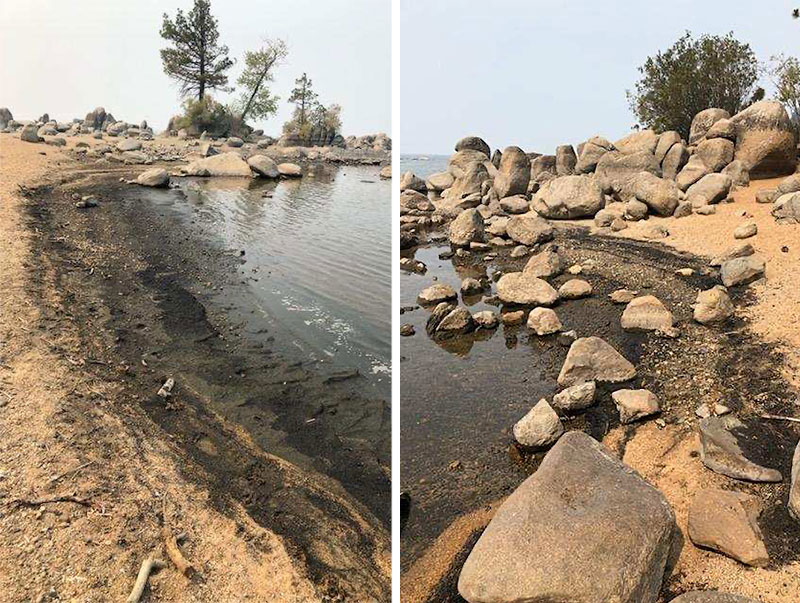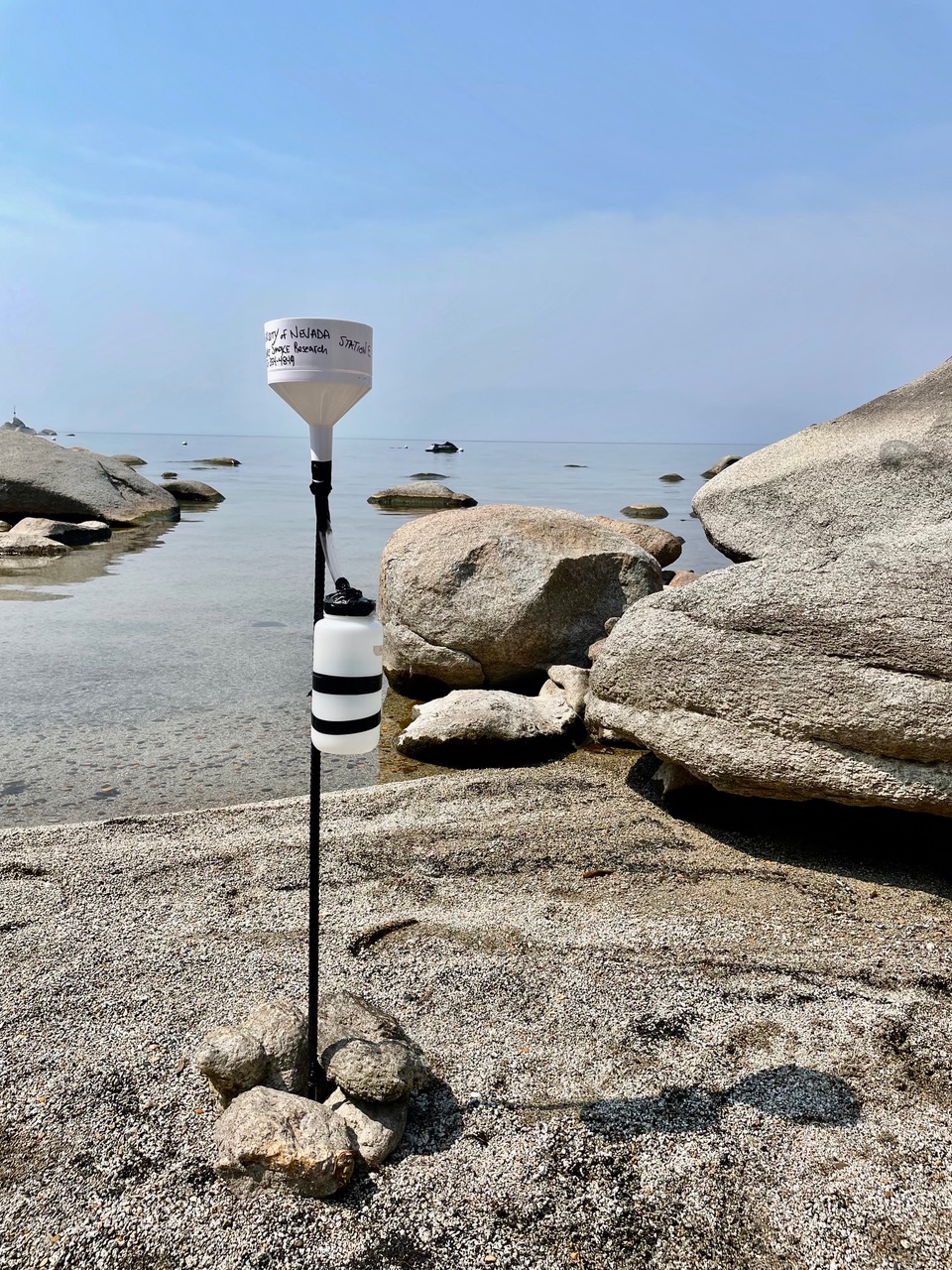As the Caldor Fire encroached on Lake Tahoe, a team of researchers from the University of Nevada, Reno began collecting samples of ash falling from the sky. Professor of Biology Sudeep Chandra is collaborating with a team of researchers across five institutions to study the effects of wildfire smoke on Lake Tahoe. Chandra is Director of the University’s Global Water Center, the Ozmen Institute for Global Studies and the project’s principal investigator (PI).
This public impact research study follows close behind the Global Water Center research completed on Castle Lake in Northern California where results showed the lake changed considerably following six wildfires in 2018 that led to smoke hanging over the water. Castle Lake is a good comparison to Lake Tahoe, and once the Caldor Fire started in the Tahoe Basin, the scientists mobilized quickly to get monitoring equipment into the lake’s watershed.
The duration and intensity of the Caldor Fire exceed that of any previous fires studied in the region. The research aims to answer questions about how the living and nonliving particles in the lake are changing due to smoke in the Tahoe Basin airshed, and what that means for Tahoe’s clarity.

The researchers found thick layers of black ash from the Caldor Fire on the shores of Lake Tahoe. Photo courtesy of the Global Water Center
“At Lake Tahoe, the water quality and clarity are declining due to particles in the water,” Chandra said. “This study is trying to address how much the smoke fertilizes the living particles versus how much of the smoke is just depositing nonliving particles, both of which cause the clarity to decline.”
The living particles that decrease water clarity are microscopic algae in the water column. Algal growth can be stimulated by the wildfire smoke in multiple ways. The wildfire smoke deposits particles into the lake which can release nutrients that fertilize the algae, causing an increase in these living particles. Algae may also benefit from the decrease in harmful ultraviolet light radiation hitting the lake due to extended periods of smoke coverage. While plants need visible light to photosynthesize, ultraviolet light radiation at high elevations is too aggressive for algae and can damage their cells. The shading of ultraviolet light may lead to increased algal growth.
To quantify how much ash is falling from the sky, researchers place elevated containers with “super clean” marbles around the lake, both far from and close to the wildfire. The containers function as collection devices and will help researchers understand what effect the quantity of smoke will have on the growth of algae and water clarity.

The bucket of marbles as a data collection method was recently developed by Dr. Janice Brahney, associate professor at Utah State University and a co-PI on this research project. This method, which she developed for her dissertation, allowed for rapid deployment after the start of the Caldor Fire. Photo courtesy of the Global Water Center.
Nearshore clarity and algae growth along the lake bottom hasn’t been as well-documented or researched as offshore clarity. Joanna Blaszczak, assistant professor in the Department of Natural Resources and Environmental Science and co-PI on the project, is hoping to change that.
“Even when we have lakes with very low nutrients, we’ve been seeing increasing algal growth on the bottom of the lake, which is greening the edges of the lake where the public interfaces the most,” Blaszczak said.
The team has already made some visual observations of the lake changing from the wildfires. Chandra said the water is visibly greening along the beaches in Southshore, and he has seen large clumps of algae growing in the lake. There are ash particles accumulating near the shores, and private homeowners in the Southeastern corner of the lake have said their water intake filters are clogging from the particles. This usually happens over the course of months but took just days when smoke from the Caldor Fire hung over the lake.
“The frequency and recurrences of these fires is going to force us to rethink what our restoration goals are. What if we have to manage to 30 feet of clarity instead of 60? What type of biodiversity might we have in the watershed and lake with the increase in fires which are expected to occur with drought conditions?"
Other potential negative effects from the wildfire include altering the biological diversity within the lake. Many species native to the lake have been in decline for decades. Understanding how the lake will change from wildfire smoke is key to conservation efforts for those species, many of which are endangered. The lake’s clarity also has implications for people, too.
“Tahoe is an amazing cultural and environmental resource,” Blaszczak said. The local economy relies on tourism, and decreased clarity, poor water quality at the edge of the lake or smokey conditions could lead to less visitation. Further, residents in the Tahoe Basin rely on the lake for drinking water, and less clean water could make it unsafe to drink.
“The frequency and recurrences of these fires is going to force us to rethink what our restoration goals are,” Chandra said. “What if we have to manage to 30 feet of clarity instead of 60? What type of biodiversity might we have in the watershed and lake with the increase in fires which are expected to occur with drought conditions? These are the questions our bistate California-Nevada Tahoe Science Advisory Council will want to answer in the coming months.”
One of the biggest challenges facing the researchers in this study was how quickly they had to act to understand the impacts from the fire. The rapid response time was extremely important because researchers didn’t know how long the Caldor Fire would last, or where it would burn. Getting funding quickly was key to the proposal’s success. The research was jumpstarted by a $70,000 donation from the League to Save Lake Tahoe, which allowed researchers to collect the time-sensitive data they needed while other agencies worked on budgeting to support the project. In three weeks, the team secured $211,000 in funding to conduct research on how wildfire smoke impacts lake water clarity from the University of Nevada, Reno; the Tahoe Regional Planning Agency; the Tahoe Fund; University of California, Davis; the Desert Research Institute; Miami University in Ohio and Utah State University.
“It takes a science village to save a lake," Chandra said. "The science and management cultures are interwoven at Tahoe and focused on preserving and restoring the watershed and lake. There is plenty of historical science information to draw from to understand the impacts from this fire.”
In the 1800s, logging led to a lot of nutrients being dumped into Lake Tahoe from increased erosion, and the influx of nutrients caused algal blooms and reduced water clarity. The lake recovered 70 years after the logging, but only because the influx of nutrients decreased over time. The frequency and intensity of wildfires is only going to increase in the coming decades, and the lake may not have enough time to recover from wildfire smoke impacts.
“As we learn to live with the prospect of more intense wildfires threatening the Tahoe Basin as a result of climate change, we must rely on the best available science from our research partners to guide decision making,” said Julie Regan, Deputy Director of the Tahoe Regional Planning Agency. “We must pivot to align our policies to build resiliency in the face of these unprecedented challenges of catastrophic wildfire and smoke impacts.”
“We protected the lake from invasive species by creating regional buffers which included boat washing stations at Lake Mead, Donner Lake and other nearby lakes. Now we’re dealing with smoke and ash," Blaszczak said. "We may have to create a regional buffer to reduce the risk of intense wildfires close to the Basin and smoke in the Tahoe airshed.” She and Chandra feel that implementing fire management plans regionally could be an approach to conserving Tahoe for future generations.
“We’ve been in the mode for 40 years of protecting Lake Tahoe based on protecting what is inside the boundaries of the Basin and the visitors and the things coming into the Basin. These fires, the Dixie, the Tamarack and the Caldor clearly show that we have to protect Lake Tahoe by thinking about actions outside of the Lake Tahoe Basin. The watershed has had fires in the past and previous indigenous societies have lived with or used fire in the region. Maybe looking at the past can inform the future,” Chandra said.
18 of California’s 20 largest recorded wildfires have taken place in the past 10 years, the impacts of which have become increasingly relevant to the Tahoe Basin. The researchers expect to produce their initial findings in early 2022.
“The Caldor Fire has provided us a glimpse into the conditions Lake Tahoe may continue to experience each fire season,” Blaszczak said. “We hope our study offers new insight into how to best manage and protect Lake Tahoe in this new era of extreme wildfires and smoke.”










